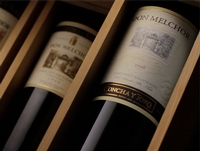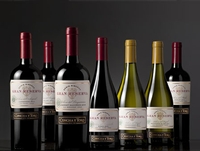Just as Gallo is the U.S.’s dominant wine firm, Moët & Chandon is Champagne’s icon, and Baron Philippe de Rothchild’s Mouton Cadet is the giant of Bordeaux, Concha y Toro is South America’s largest and most  important producer. The difference for Concha y Toro is that its dominance is a fairly recent occurrence–taking place mainly within the last 25 years.
important producer. The difference for Concha y Toro is that its dominance is a fairly recent occurrence–taking place mainly within the last 25 years.
Concha y Toro’s growth surged in 1987, when the U.S. based Banfi Vintners, renowned for its Brunello di Montalcino and other Italian wines, began distributing the wine worldwide. At about the same time, Chilean wines started becoming popular in the U.S., UK, and other world markets. Today, Concha y Toro wines are available in over 130 countries.
Concha y Toro became a full-fledged international winery when it acquired Brown-Forman’s U.S. wine line in 2010, which included Fetzer Vineyards, Bonterra, Jekel, and Little Black Dress.
Concha y Toro has many subsidiary labels, led by its premium wine, Don Melchor Cabernet Sauvignon–named after its founder. Don Melchor’s  first vintage was its 1987. Entirely Cabernet Sauvignon (with a little Cabernet Franc added in some vintages), Don Melchor was Chile’s first ultra premium (a.k.a. super-Chilean) wine, and remains today one of Chile’s best wines. The 2008 is its current vintage.
first vintage was its 1987. Entirely Cabernet Sauvignon (with a little Cabernet Franc added in some vintages), Don Melchor was Chile’s first ultra premium (a.k.a. super-Chilean) wine, and remains today one of Chile’s best wines. The 2008 is its current vintage.
Other Concha y Toro brands include Amelia, Terrunyo, Marques de Casa Concha, Gran Reserva Serie Riberas, Casillero del Diablo, Trio, Sunrise, Xplorador, and Frontera. One of Concha y Toro’s large subsidiary wineries is the well-regarded Cono Sur. The owners of Concha y Toro, the Guillisasti family, also own Emiliana Organic Vineyards and Winery, which they run separately.
Concha y Toro began making wines in Maipo Valley in Chile’s Central Valley, but at this point the company is producing wines in almost every winemaking region in Chile–including Límarí, one of Chile’s newer wine regions, a high-altitude, desert-like area in the north, with a strong coastal influence–as well as several regions in Mendoza, Argentina. Concha y Toro’s five primary varieties in its various wines are Cabernet Sauvignon, Merlot, Carmenère, Chardonnay, and Sauvignon Blanc.
Heading up the winemaking for Concha y Toro is Enrique Tirado, with  the winery since 1993. Tirado is chief winemaker, and in personal charge of Don Melchor wines.
the winery since 1993. Tirado is chief winemaker, and in personal charge of Don Melchor wines.
Recently, I attended a tasting of the latest vintages of two Concha y Toro wine brands–the Gran Reserva and Marqués de Casa Concha–along with the two respective winemakers. The wines are two of Concha y Toro’s medium-priced brands, and are well-represented in the market. Gran Reserva‘s white wines retail in the $16 to $17 range, while Marqués de Casa Concha’s whites are in the $18 to $19 range. Marcio Ramírez, former Assistant Winemaker of Don Melchor, is in charge of Cabernet Sauvignon and Carmenère Gran Reserva wines; Marcelo Papa is chief winemaker of Marqués de Casa Concha, and Enrique Tirado’s right-hand man.
All of the Gran Reserva wines are from the “Riverbank Series,” with the varieties grown near river banks; all the rivers were formed by the rushing, mineral-rich, melted snow waters of the Andes Mountains.
I tasted and compared Sauvignon Blancs, Chardonnays, Carmenères, and Cabernet Sauvignons from the Gran Reserva line and Marqués de Casa Concha line, plus one Marqués de Casa Concha Pinot Noir. In each case, I preferred the Marqués de Casa wine. Wines from the Gran Reserva series were good, but the slightly more expensive Marqués de Casa Concha series proved to be even better.
The two Sauvignon Blancs were both from the 2012 vintage, harvested just six months ago. The Gran Reserva was sourced from Colchagua Valley (south of Maipo); and the Marqués de Casa Sauvignon Blanc from Leyda Valley (within San Antonio Valley) along the Pacific Coast. Both wines were excellent; the Gran Reserva had lively acidity and great minerality, with intriguing aromas and flavors of lime. The Marqués de Casa Concha was even better, with intensely Sauvignon varietal flavors, zinging with acidity, and pronounced flavors of grapefruit. It was clearly my favorite white wine of the tasting.
It is gratifying to me how Chile has progressed with Sauvignon Blanc, a mediocre varietal wine here a decade ago. Now, with improvement in clonal material and planting in cooler areas, Chile has emerged as one of the leading countries in the world for this varietal wine. By the way, the two wines were aged in stainless steel tanks only, with no oak aging–which they obviously did not need.
The two Chardonnays were 2011s, the Gran Reserva from the Colchagua Valley, and the Marqués de Casa from Limarí Valley. Winemaker Marcelo Papa believes that the semi-arid, cool Limarí holds “enormous promise, most especially…with Sauvignon Blanc and Chardonnay,” but also with Pinot Noir. Both wines were aged partially in 100 percent new oak. In this case, the Marqués de Casa Concha Chardonnay was clearly the finer wine; it was full-bodied, with crisp acidity. A wine for Chardonnay lovers, which I am not (with some memorable exceptions).
We then tasted 2011 Marqués de Casa Concha Pinot Noir, also from Limarí Valley. It had some oak aging. I found the wine light-bodied, but very pretty and very drinkable, with strawberry aromas and flavors. It’s ideal for drinking on warm, summer evenings. I enjoyed this Pinot Noir (about $22) very much, but I do like this type of wine. If you’re looking for a more full-bodied Pinot Noir–which I suspect cannot be produced in this cool, very high-altitude terroir–this is not your wine.
Then we concentrated on the two primary varietal wines in the Gran Reserva and Marqués de Casa Concha lines, Carmenère and, of course,  Cabernet Sauvignon. The two Carmenères were from the 2011 vintage, both aged in French oak. The Gran Reserva Carmenère, with 10 percent Cabernet Sauvignon, was also sourced from Colchagua Valley. It is very drinkable even now, and well-priced at $17. The Marqués de Casa Concha Carmenère, whose grapes grew in Rapel Valley, was aged for 18 months in French oak. It ranges in various vintages from 88 percent to 95 percent Carmenère; the 2011 ($22) contains 95 percent Carmenère, with 5 percent Cabernet Franc. The 2010 version had 12 percent Cabernet Sauvignon. The 2011 Marqués de Casa Concha Carmenère is a lovely wine, with the classic aromas and flavors of black plums, and it should improve with another year of aging.
Cabernet Sauvignon. The two Carmenères were from the 2011 vintage, both aged in French oak. The Gran Reserva Carmenère, with 10 percent Cabernet Sauvignon, was also sourced from Colchagua Valley. It is very drinkable even now, and well-priced at $17. The Marqués de Casa Concha Carmenère, whose grapes grew in Rapel Valley, was aged for 18 months in French oak. It ranges in various vintages from 88 percent to 95 percent Carmenère; the 2011 ($22) contains 95 percent Carmenère, with 5 percent Cabernet Franc. The 2010 version had 12 percent Cabernet Sauvignon. The 2011 Marqués de Casa Concha Carmenère is a lovely wine, with the classic aromas and flavors of black plums, and it should improve with another year of aging.
Some writers believe that the almost-forgotten, late-ripening Carmenère, a refugee from Bordeaux (where it was never really suited to the climate, with Bordeaux’s autumn rains) is Chile’s future star variety–as Malbec, another Bordeaux refugee, has become in Argentina. I was one of those writers, at one time. But as time passes, I’m becoming less convinced of Carmenère’s future stardom in Chile. Carmenère does make a pleasant, very drinkable wine when grown in the right area (with a mild, dry climate in autumn that allows the grape to fully ripen), and especially when some Cabernet Sauvignon and/or Merlot is added to the blend. But I believe that Carmenère will never have the structure or majesty of a great Cabernet Sauvignon. I could be wrong. Time will tell.
Up until now, at least, Cabernet Sauvignon has been Chile’s best red varietal wine, most suitable to the country’s terroir. The two 2010 Cabernet Sauvignons I tasted, just being released, confirmed my beliefs about the excellence of these varietal wines. The Gran Reserva Cabernet Sauvignon ($17), 90 percent Cabernet, 10 percent Merlot, was well-balanced, with more intense fruit flavors than you would expect from a seventeen dollar wine, and soft tannins. You can drink it now, but it will be fine for at least a few more years. Its vineyard is in Colchagua Valley.
Marqués de Casa Concha’s Cabernet Sauvignon was my clear choice as the top red wine of the group. Sourced from the renowned Puente Alto Vineyard in Maipo Valley–the same vineyard site of Concha y Toro’s Don Melchor–it has enormous concentration, firm tannins, and a long finish. The 2010 Marqués de Casa Cabernet Sauvignon contains 93 percent Cabernet, 6 percent Carmenère , and 1 percent Petite Verdot. A great value at $22, this “junior Don Melchor” should age well for at least ten years.
I was impressed with the new releases of both of these brands of Concha y Toro, the Gran Reserva and Marqués de Casa Concha. In particular, the 2012 Marqués de Casa Concha Sauvignon Blanc and the 2010 Marqués de Casa Concha Cabernet Sauvignon stood out as outstanding wines. And I continue to admire the ability of the Concha y Toro firm to produce excellent, good-value wines year after year.
